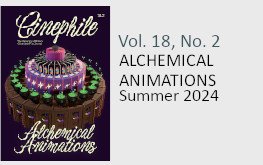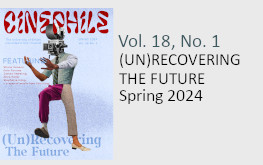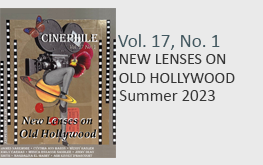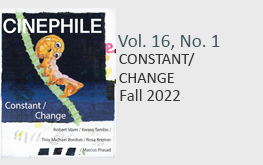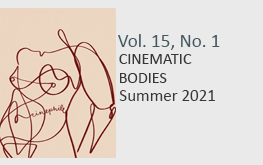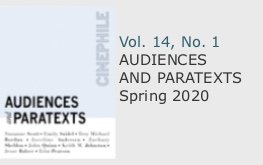Colleen Montgomery and Brent Strang
Outfit a scantily clad model with an SS symbol and you’re sure to grab people’s attention and elicit some strong reactions. Lest you be fooled by our cover model, let us be clear: our journal has no neo-Nazi aspirations. Cinephile, however, has never shied away from controversial topics. From Slavoj Žižek’s “The Family Myth in Hollywood,” which examines the ‘true Evils’ of so-called ‘utopian socialist’ gated communities, to Brenda Cromb’s “Gorno,” which grapples with the recent cycle of ‘torture porn’ films, Cinephile, it seems, is fixated on contentious and unsettling art. So it is only fitting that, in this, our 5th anniversay issue, we set out to navigate the murky and uncharted depths of ‘alternative cinema’. But carving out an epistemology of this amorphous cinema is no small endeavour-and what do we mean by ‘alternative cinema’ anyway? On the one hand, it is always evolving, always repositioning itself outside mainstream modes of representation: once the mainstream appropriates elements of alternative style, new configurations naturally spring up in response. At the same time, it has no singular mandate, no fixed ideological underpinnings, and is beholden to no specific national cinema or film movement.
Rather than restricting ourselves to film studies jargon and taxonomies (such as ‘art-house’, auteurist second cinema, or the politically alternative third cinema), we have taken a different tack. We purposely cast a wide net to dredge up a diverse mix of strange and lesser-known fish, discovering in the process, counter currents to the mainstream of Hollywood’s global vernacular-the biggest fish in the pond, so to speak. From the nasty and the deviant, to the politically radical, to auteurist fare that tests the limits of style, taste and formal experimentation, anything which defies, perplexes and sits at odds with convention lies within our purview. Our intention is to introduce new viewpoints and new language for speaking about these unusual creatures. This issue ought, finally, to resemble something of a mirror ball, reflecting back to the reader flashes of insight, but offering no dogmatic, universal conclusions; any emergent conception of alternative cinema must take into account its perpetual state of flux, and thus its resistance to rigid formulations.
What insights and new language, then, have we discovered in mapping this course? We begin with two essays that address the problematics of Third Reich representation: Steffen Hantke complicates notions of high concept in his keen observance of the act of performing Hitler, whereas Graeme Krautheim delves into Nazi sexploitation films (a cycle long ignored by scholarly research) arguing that these ‘deviant criminals’ can actually be viewed as historical documents. Thomas R. Britt examines how two films, infamous for their sex and violence, actively unify excessive content with structural, visual and psychological depth. In a more political vein, Jerry White demonstrates how mixing media facilitates the aesthetic and ideological ambitions of Finnish director Pirjo Honkasalo, while Tia Wong surveys alternative modes of spectatorship and the resistant gaze in two of Alanis Obomsawin’s documentaries. Unearthing alternative national histories, Colleen Montgomery explores Alexei Balabanov’s ‘heritage porn’, and Laurynas Navidauskas discusses ‘prosthetic memory’ in Sally Potter’s Orlando. Finally, William Beard’s interview highlights the importance of serendipity and technical inexperience in the birth of Guy Maddin’s distinctive style, while Brenda Cromb puts to question her own cheerful embrace of sleaze in her review of Jeffrey Sconce’s Sleaze Artists.
Informed by both a scepticism of aging theoretical frameworks and an enthusiasm for new, interdisciplinary perspectives, this collection of articles is aptly suited to the journal’s mandate of stretching the bounds and habits of the film studies discipline. We invite research attuned to the dissolution of boundaries (film/cultural studies, film/video, high/low art, etc.) and encourage articles that deploy film theory with a clever balance of novelty and irreverence. Emergent trends within the industry, mixed media, changing distribution, exhibition and reception patterns all peak our interest, and if these discussions may be complicated or contentious, so much the better. In keeping with this mandate, Cinephile is expanding, moving to bi-annual publication (watch for Vol.5 No.2, “The Scene,” in summer 2009!), partnering with UBC’s Ejournal project to create an open access venue and offering a host of new multimedia features on our website, cinephile.ca. We couldn’t have done it alone though, and wish to acknowledge our advisor Ernest Mathijs, our ‘go-to’ people, Gerald Vanderwoude and Jennifer Suratos, our illustrator, Bobby Mathieson, our layout editor, Andrew deWaard, our editorial board and, of course, UBC’s Department of Theatre and Film-whose continued support has allowed the journal to grow and flourish.
Satisfy your inner cinephile and become a subscriber! In addition to our penetrating, original content, Cinephile is guaranteed to keep your coffee table on the cutting edge-after all, an SS cover model is sure to make for a lively and certainly alternative conversation piece.

